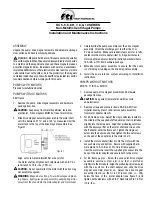
3
309098
TOXIC FLUID HAZARD
Hazardous fluids or toxic fumes can cause serious injury or death if splashed in the eyes or on the
skin, inhaled, or swallowed.
D
Know the specific hazards of the fluid you are using.
D
Store hazardous fluid in an approved container. Dispose of hazardous fluid according to all local,
state and national guidelines.
D
Always wear protective eyewear, gloves, clothing and respirator as recommended by the fluid
and solvent manufacturer.
MOVING PARTS HAZARD
Moving parts, such as the air motor piston, can pinch or amputate your fingers.
D
Do not insert fingers in overflow port when filling reservoir.
D
Keep clear of all moving parts when you start or operate the pump.
D
Before you service this equipment, follow the
Pressure Relief Procedure
on page 9 to prevent
the equipment from starting unexpectedly.
INJECTION HAZARD
Fluid from the dispensing valve, leaks or ruptured components can inject fluid into your body and
cause extremely serious injury, including the need for amputation. Fluid splashed in the eyes or on
the skin can also cause serious injury.
D
Fluid injected into the skin might look like just a cut, but it is a serious injury.
Get immediate
surgical attention.
D
Do not put your hand or fingers over the end of grease outlet.
D
Do not stop or deflect leaks with your hand, body, glove or rag.
D
Follow the
Pressure Relief Procedure
on page 9 if the injector clogs and before you clean or
service this equipment.
D
Tighten all fluid connections before you operate this equipment.
D
Check the hoses, tubes, and couplings daily. Replace worn or damaged parts immediately. Do
not repair high pressure couplings; you must replace the entire hose.
D
Fluid hoses must have spring guards on both ends to protect them from rupture caused by kinks
or bends near the couplings.
WARNING


































